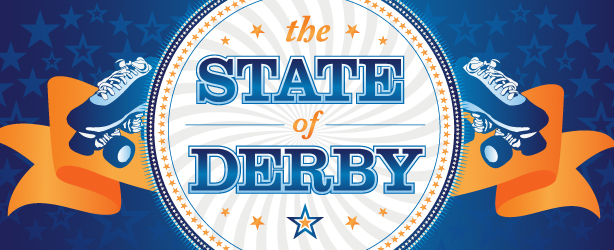Since the rebirth of roller derby, the modern version of the sport has undergone many changes. Not all changes are to everyone’s liking or fit into what they want roller derby to be. Hence, we see several organizations playing various types of roller derby: flat-track, banked-track, women’s derby, men’s derby, co-ed derby, junior derby, etc. Until recently, there have been few governing bodies representing these various styles of derby, but recently several organizations have emerged that warrant some comparison and discussion. As such, we’ve sent invitations to representatives of all the roller derby organizations we know of, and a few other key personnel who are influential in the sport, to participate in our first-ever annual “The State of Derby” series. This will be RDIT’s annual update on the roller derby world, heard directly from those who have a voice or position of influence within the sport of roller derby. Just as the President of the United States delivers a State of the Union address, each individual will be given the opportunity to offer their perspectives on the challenges facing the sport, their vision for development, and how their organization fits in the roller derby world. After we publish the detailed responses of all who respond, we will summarize the major points in info-graphic form for quick reference.
Our initial list of invited participants for 2011 are:
- Jerry Seltzer, *aka The Commish – *Former roller-derby promoter and son of roller derby inventor, Leo Seltzer.
- Liz Mikolajczyk,* aka Baby Skates Nelson* – OSDA (Old School Derby Association)
- Brandy Tomhave,* aka Marzipain* – MADE (Modern Athletic Derby Endeavor)
- Troy Twibell, aka Major Problem! – JRDA (Junior Roller Derby Association)
- Julianna Gonzales,* aka Bloody Mary* – WFTDA (Women’s Flat Track Derby Association)
- Danielle Krienert – USARS (U.S.A. Roller Sports)
- Catarina Noto – FIRS (Fédération Internationale de Roller Sports)
- Erich Bennar, aka Dr. Spankenstein – MRDA (Men’s Roller Derby Association)
We begin The State of Derby series with a perspective from Jerry Seltzer:
Through the ages with Roller Derby
I saw my first game in 1938 and my last one on May 21, 2011.
Believe it or not, it is basically the same: 5 members of each team on the track, attempting to block each other to get their jammers out and blocking the other team’s jammers, with two minutes to complete a scoring play.
There are a few differences: today’s game is predominately played by women on a flat track and is 100% legitimate.
Do not think that the skaters of past years were not great skaters. Most skated five games a week for years and were wonderful athletes. Because the presentation to the public was different, the game started out with set plays and remained that way.
Leo Seltzer really loved the game but with his background in athletics wanted it to become fully legitimate and be in the Olympics. He never got to see his dream realized and died in 1978, 5 years after the last game.
Would he be happy with today’s game and its participants? Yes and no. He always only thought of it with men and women competing (separately), and I agree with him. He also would have felt the massive amount of rules, referees and officials would be excessive, as I do.
Because the players basically own the game (nothing wrong with that), it is played with them in mind and not the spectators. I feel that that is one reason it has not moved up to the next level.
Obviously many of today’s participants want the flat track game to stay as it is, and since they have the control of their leagues, that is what will happen; and there will continue to be great growth, as there is with the many amateur soccer leagues. However, to become a successful spectator sport on a major league basis (6 to 8 team leagues, with a continuous full schedule of all teams competing against each other), there will come a separate entity, with a game aimed more at the spectators (and fully legitimate!), probably on the banked track, and with rule changes to simplify the game but still protect the players.
Remember, we drew all of our talent for 6 and then 8 teams from a pool of only several hundred skaters in training, most of who had never skated before. Today, there are literally tens of thousands of people who are members of Roller Derby leagues, and I am certain there is at least a thousand who would want to play professionally. And since the game has grown universally, so much would be added in interest by international competitions.
Unfortunately, I am beyond the age, interest, and resources to be part of this, but it is out there. My concern is that “promoters” will grab on to it and we may even get something worse than rollergames and Rollerjam.
I feel what I described is inevitable. Realize how successful so many leagues are in so many cities with the ability to skate the game properly and to draw fans. It is only logical that that some future expansion will happen.
- Jerry Seltzer
Next: OSDA and JRDA responses. We’ll see what those who feel they are holding true to roller derby’s past have to say as well as those who believe they are the future of derby.
-Captain Gorgeous
*Special thanks to Jennemy of the Skate for creating The State of Derby graphic
